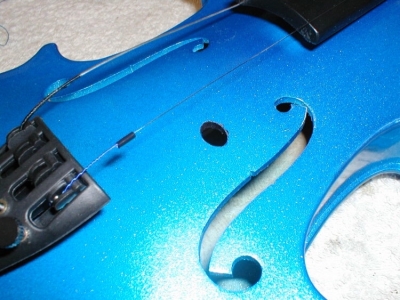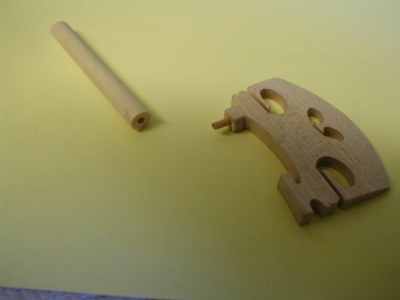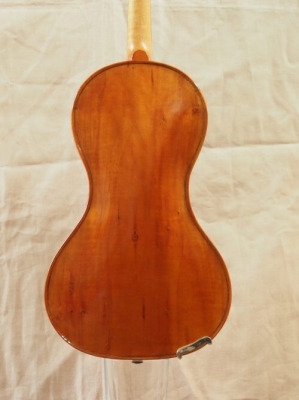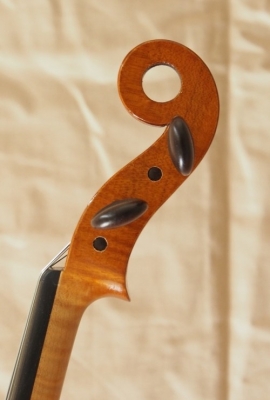Welcome to our forum. A Message To Our New and Prospective Members . Check out our Forum Rules. Lets keep this forum an enjoyable place to visit.
Currently working on errors from the latest (SimplePress) forum update. Many issues have been resoled and others are being worked on. Thank you for your patience.
 Topic RSS
Topic RSS



 (3 votes)
(3 votes) Regulars
 Offline
Offline

Regulars
 Offline
Offline

Hi @Mouse and others. The sound post is projected through the hole in the belly. Not sure of the construction of the bridge “dowel.” I would think that you would want to use something strong and light to avoid inertia (like a titanium or carbon fiber pin). It might also be possible to joint the sound post and bridge together and secure with glue.
Success is the progressive realisation of a worthy ideal. —Earl Nightingale.
Regulars
 Offline
Offline
Regulars
 Offline
Offline

My assumption is that the treble frequencies are relegated to the less resonate back plate and the bass frequencies favored on the belly plate.
Harbor Freight makes an automotive spot weld removal cutter that would be perfect for the heart hole. A hollow diamond hole cutter might also work without splintering the back side of the plate.
Of course, I would also reduce the size of the tail piece.
Success is the progressive realisation of a worthy ideal. —Earl Nightingale.
Regulars
 Offline
Offline


Regulars
 Offline
Offline

Regulars
 Offline
Offline


Regulars
 Offline
Offline

Hi @@bocaholly and others. Sound post placement normally has great importance for the resonance of the top plate. The whole purpose of this contrivance is to divorce the top plate from amplifying the output of the treble strings. The bass string component is unaffected. The acoustic balance of the instrument is therefore skewed toward the bass. Foreward and aft bridge positioning would change string length and is prevented by the size of the sound post hole.
This admitted butchery is restricted to low cost instruments in small sizes to provide a flavor of the sound of a proper viola.
Success is the progressive realisation of a worthy ideal. —Earl Nightingale.
Regulars
 Offline
Offline
I have mentioned before, and still hold to the position, that any modification to your instrument should be done by a professional luthier. And if the luthier advised against any such modification, I’d listen very carefully.
The violin we know today has changed little in 500 years.
If the master, Antonio Stradivari was here, I’d like to run this one past him once.
I’d also like to shake his hand!!! But that’s for another thread.
- Pete -
Regulars
 Offline
Offline


Thanks for the extra explanations, @Irv.
Couldn't resist googling "hole in the heart viola". Lo and behold, this is actually something that has been done by pros and amateur luthiers to achieve exactly the results you expect on inexpensive fractionals.
I know you have a few other projects going but are you going to try this too?
Regulars
 Online
Online





Regulars
 Offline
Offline

Hi @@Gordon Stumway and others. Fractional violins are notoriously bright creatures and this is a low cost method of mellowing them out. Obviously, it does nothing to increase air volume in the corpus (the Sabatier fractional viola will do that, but costs a good deal more money).
@bocaholly, most of my instruments were obtained inexpensively and I could easily do this, but I lack anything bright enough to make it potentially worth while. If I had a grand child that wanted to play the viola, I would either buy them a Sabatier and/or make them a clone of one.
@Pete_Violin, you are of course entitled to an opinion, but I see no logic is spending $150 to a luthier to modify a $40 instrument (assuming an eBay purchase for said instrument, of course). I see it as a potential bonding moment between child and adult. Using the provided photographs, this procedure is easier than righting a fallen sound post.
Success is the progressive realisation of a worthy ideal. —Earl Nightingale.
Regulars
 Offline
Offline
@Irv
Sorry, I did not mean to imply that one should waste time and money with a luthier for a simple procedure on an inexpensive instrument. You clearly have much more experience than me with modifications and repairs on instruments. I simply do not have the confidence or experience to do anything even close to what you are describing with this type of modification. Nor do I have a spare instrument that I can risk damaging. Not even a cheap one.
Also, I always recommend to anyone (and remember there are many who read this forum) that an experienced luthier is invaluable and can prevent someone from damaging their instrument, whether that instrument is worth $40 or $400, leaving aside that the monitary value is only one aspect a player holds with their instrument.
And I would point out that a luthier is worth their weight in gold. It is never a waste of time, for me at least, to discuss modifications with a luthier.
If I was out of line, I apologize. I certainly did not mean to be. Nor did I want to imply that you were being irresponsible with your post.
- Pete -
Regulars
 Offline
Offline

Hi @Pete_Violin. Absolutely no offense taken by your comment. We simply see the violin under different perspectives.
You see a object of art that reached the pinnacle of perfection 300 years ago and has been in retrograde ever since. I see a slightly sub-optimum but beautiful tool subject to modification to suit the user.
The experience and training of a willing luthier would always be an advantage, if available. It is a pity that their voice is not evident on this forum. Perhaps @Fiddlerman should avail his luthiers for such a voice.
My best experience viewing a post on the forum was a video of Maxim Vengerov (a player previously unknown to me). While I immensely enjoyed the sound of his playing, I also enjoyed cataloging the various supplements he had made to the basic instrument to assist his technique.
I doubt that any members of the forum will subject an instrument to a hole in the top plate, but a guest might. And the guest might be the parent of a future Maxim.
Success is the progressive realisation of a worthy ideal. —Earl Nightingale.
Regulars
 Offline
Offline
Regulars
 Offline
Offline

Further back in the thread, someone mentioned the dowel connection between the bridge and the sound post. I did some browsing at it appears that a ground off piece of sewing machine needle is a suitable material. 2mm and 3mm titanium rod can also be obtained inexpensively from China (5 each of 10 inch length for less than $3 inclusive of shipping).
I also read that the belly hole needs to be oversized, particularly when dealing with young students, to prevent a buzz from occurring if the sound post comes in contact with the belly plate.
Success is the progressive realisation of a worthy ideal. —Earl Nightingale.
Regulars







@Pete_Violin, luthiers develop their skills by doing, of course... and presumably they start with repairs (and perhaps experiments) on inexpensive instruments. I wouldn't dare cut into my good viola, but if I had the spare time and workshop space I'd consider getting cheap instruments and violin kits to start learning and experimenting. I think it would be better to do it with the advice of an experienced luthier, of course.
I'm less wedded to traditional forms of instruments because I mainly play viola and not violin. The viola is a compromise instrument to begin with, so it has been the subject of a lot more experimentation over the years than the violin -- hence the Rivinus and Iizuka viola patterns I've posted elsewhere on this forum. (Interestingly, the Rivinus pattern also has extra holes in two corners.) For that matter, my own instrument is a Tertis pattern viola, a shape developed in the 1930s. It's not as radical a departure as the other two patterns I mentioned -- from a distance a Tertis pattern viola looks similar to other violas -- but it's still an example of a new shape created through modern tinkering.
Regulars
 Offline
Offline

For those with an interest, check out the December 2000 Strad Magazine article entitled: “Too Small to be Beautiful?” starting on page 1350. The “dark horse” 60£ Chinese fractional violins with the 35£ hole in the heart modification kicked butt against Sabatier amoeba-shaped violas and Tertis viola clones (among others) in a blind sound test with 60 music teachers and makers. All entrants used donated Corelli Crystal strings.
Success is the progressive realisation of a worthy ideal. —Earl Nightingale.
1 Guest(s)


 Log In
Log In Register
Register




















